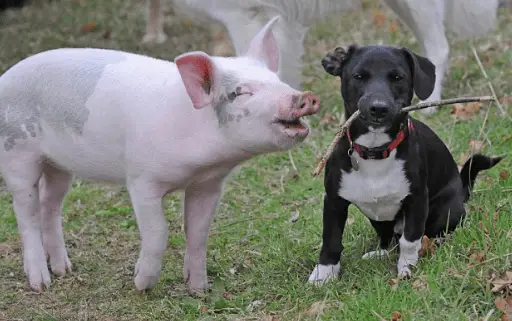If you truly want to give your pig what it needs and wants, it is important to understand what it’s trying to tell you when it makes different sounds.
Why do pigs oink? They do this to communicate with other pigs around them. You can call it their language, a way to let others understand how they feel and what they need.
Aside from using the sounds they make to communicate with other pigs, they also use this to communicate with other animals, as well as humans, around them.
Of course, as a proud owner of a pig, you have to be able to understand what it’s trying to say when it oinks or makes any other noise. As you read on, you can at least have some foundation on what these different sounds may mean. You would also understand other tactics pigs use to communicate with you.
The Different Sounds a Pig Makes
We’re used to associating pigs with the “oink” sound mostly because this is what we’ve been taught when we were kids. But in reality, pigs make a myriad of other sounds, depending on its mood and what it wants to say.
The basic rule is this — high-pitched noise is usually a product of stress, while lower pitched noise would be a sign of comfort.
Here’s a look at the different sounds a pig makes to help you better understand what they’re trying to tell you:
- Clacking or jaw chomping
This is usually a sign that your pig is agitated or angry. Be prepared because your pig may start to become aggressive. Check your surroundings for potential threats that’s causing your pig to make this sound.
- Teeth grinding
When you hear your pig making a grinding sound, this may signal two different things. It’s either agitated, or is feeling pleasure. It would help to understand the situation at that specific moment to understand what the teeth grinding means.
If the pig is pacing or restless at the same time it’s grinding its teeth, it could be agitated. Look around. Is there another animal nearby that could be causing the agitation? Is it past its meal time and its food has not been brought out yet?
If you hear your pig grinding its teeth while you’re giving it a belly rub or while it’s relaxing under its favorite blanket, then this means that it’s content and satisfied.
- Screeching
If your pig lets out a shrill screeching sound, you should start looking at what it’s screeching at. This is a clear sign that it is threatened and is agitated towards a specific thing.
Check if it’s screeching at your dog, it could be scared either because the dog is being aggressive, or because the dog is unfamiliar and is being seen as a threat.
If your pig is screeching at a person, it’s possible that this person has caused trauma to the pig before. For example, the person may have hurt the pig in the past, whether by accident or on purpose. Something as simple as shouting at your pig could be traumatic to it, so don’t be surprised if it screeches at you even a few days after you lose your temper with it.
On another hand, if your pig is screeching directly at you and you’re positive that you didn’t do anything wrong, then this is a clear sign that it’s expecting you to do something for it. For example, it may be thirsty and is asking for water. It could also be bored and just want you to bring out its favorite toys.
- Grunting
A pig makes grunting sounds more often than it makes any other noise. It’s the main sound they make to communicate with other pigs. So when you see a group of pigs grunting at each other, just imagine what you and your friends do when you sit around and talk about your week. That’s it for them.
- Sounds reminiscent of monkey noises
What do we mean by monkey noises?
This is usually a series of “oof oofs” and “aaah aaahs”. It’s not super loud. But what it means is that your pig is excited and happy to see you. It’s possible that you were gone the entire day and it missed you. It could be getting your attention.
Pigs may also make this sound when they are excited about what’s coming. For example, you may be approaching with its favorite toy in hand. This could be a source of excitement that causes your pig to make this sound.
- Screaming
When pigs scream, you will definitely have no other choice but to sit up and take notice. Their scream can send anyone to a panicked state, considering the high pitch and the loud decibel level. This sound will always be accompanied by jerky and tensed movements.
This is a sign of great distress. Your pig is most likely in great pain or is experiencing fear. Act quickly when this happens and start looking for triggers right away.
Is your pig on a leash? Check right away and see if the leash is attached comfortably and is not restricting the pig’s airway or is not clinching its skin tightly. Check for people or other animals around it as well that may have hurt it or are in the process of hurting it.
It’s also possible that your pig is highly overwhelmed. Did you just place your pig in a tub or pool for a bath? Check the water temperature. It may be too cold or too hot.
You should also check for safety hazards. Your pig may be slipping around the tub, for example. If this is the case, remove your pig from the tub and calm it down. Then, place rubber mats that would add some traction so that you can show your pig that it’s now safe to go in.
Introducing new things to your pig has to be a slow process. Don’t surprise or overwhelm it to avoid additional stress or trauma.
- Barking
This may come as a short and abrupt sound, or it may be done in succession. This usually means that your pig is spooked and is detecting something that could somehow be threatening.
This is also a sound they make when they are startled, especially if it’s just one sharp bark.

Other Ways Your Pig Communicates
Aside from the sounds that it makes, pigs also communicate using two other things — body language and scent.
Although it can be intriguing for humans to find out what a pig is trying to say through its different smells, there are specific scent signals that only their own species can understand. This is why when humans are trying to make sense of what a pig is trying to say, we’d rather stick to their vocal cues and body language.
Your pig only sends you 3 different messages through its body language — asserting dominance, showing submission, or displaying fear or anxiety.
- Asserting dominance
Your pig may start asserting its dominance if it sees someone that it is unfamiliar to. You see, pigs are used to being part of a herd. If your pig is the only animal you have at home, then it will consider you as its herd. So anybody unfamiliar to it could be seen as a threat that it would have to scare off.
Pigs show dominance when it uses stiff and tight body language. You may notice that it has jerky movements. It could start swiping its head from left to right and will start chomping its jaws. You may also notice some foaming at the mouth.
While this is more normal for full-grown pigs, a pig’s actions would also depend on the level of threat that it feels.
- Showing care or submission
It would be great if your pig is at this state all the time. When a pig is showing care or submission, it is relaxed and slow moving. It is noticeable how the pig moves about in a carefree manner as if it has no other care in the world.
They may also be a little playful at times and can start galloping or spinning around. On a slow day, it could be contented with just lazily strolling around the yard.
You may sometimes notice your pig coming close to you and breathing hot air to your legs or feet. This is actually a sign that your pig trusts you and wants to offer comfort.
- Displaying fear or anxiety
This is something that your pig may display the first time it meets you. They feel fear and anxiety when they enter unfamiliar territory.
When your pig is stressed, fearful or anxious, it is evidently reactive to the smallest movements. You could walk towards it and it may suddenly squeal and jump around. It uses a forward-facing posture. It would also stare at you and try not to break eye contact because it’s waiting to see what your next move would be.
Related Questions
Why do pigs like mud?
Pigs do not just use mud pools to relax. They also love how the mud cools down their skin. Mud is also a great way to protect the pig’s skin against the harsh rays or the sun. It can also prevent insects and parasites from biting the pig or staying on their skin.
What does it mean when a pig wags its tail?
Pigs wag their tail when they are happy or contented. This is the same attitude we see on dogs that are excited or happy.

